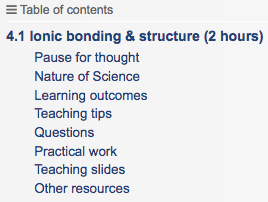Using student access
Make much of this site available to your students
Introduction
 This website is primarily for IB chemistry teachers but the aim of all of us is to enable our students to realise their full potential and gain as high a mark as possible in chemistry for their IB Diploma.
This website is primarily for IB chemistry teachers but the aim of all of us is to enable our students to realise their full potential and gain as high a mark as possible in chemistry for their IB Diploma.
There are many different ways to teach the two year course and each teacher will have his/her own way of approaching this. The site is arranged in a flexible way so that teachers can tailor it to suit their own individual way of teaching. Irrespective of exactly how you deliver the course, it is well worth giving students direct access to large parts of the site as it contains much that they can use on their own to improve their knowledge, understanding and enjoyment of chemistry. It is also free to all students in subscribing schools.
The amount of access you give to your students can be controlled directly by you.
Some of the pages are only available for teachers to see, some are available to students if their teacher allows it and others are always available for viewing by students. However your students can only gain this access if you set it up for them. I strongly encourage you to do this. Instructions on how to do this are given in Creating student accounts.
Once your students have access you will be able to monitor and record the marks for all the assignments you set them, whether or not the questions etc. come from this website or elsewhere, and also see when and for how long they have spent on them. To get step-by-step information on how to do this with examples see Managing student accounts & mark book.
Advantages to students who have access
You will need to explore the site thoroughly for yourself but students should find the following particularly helpful.
1. Pages on each topic & sub-topic in the core/AHL and all four options written specifically for students in “Complete course for students”
 Each sub-topic (there are 53 of them in the core/AHL) has a table of contents at the top and consists of essentially six main sub-headings.
Each sub-topic (there are 53 of them in the core/AHL) has a table of contents at the top and consists of essentially six main sub-headings.
Learning outcomes – covers the understandings, applications and skills and guidance listed in the syllabus.
Relationships and vocabulary – covers links to the nature of science and international- mindedness and lists essential vocabulary.
Learning slides – a slide gallery covering all the content and syllabus for the sub-topic together with some worked examples (tasks). These are particularly helpful when it comes to reviewing/revising the whole programme before the exams.
Something to think about – investigates something of interest about the topic and in many cases covers the nature of science as often it looks at the history or validity of the sub-topic.
Test your understanding - Covers two different types of questions. There are 10 'ready made' multiple choice ‘quiz’ questions on each sub-topic. These are helpful as they also contain the explanation for the correct answer. They can be done in class or as an assignment but the mark cannot be automatically recorded. If you do want to record the mark then the same questions can be found in the qBank and you can chose your own questions from more than 850 to use in a quiz. The other questions are short-answer questions and there is a separate page with the worked answers. All the quiz and question pages are controlled by you as to when you want to give your students access to them. For example, you might set the short-answer questions on a particular sub-topic as an assignment then, when you have collected in their answers, you can give them access to the worked answers page.
More resources - these usually include videos etc. that students will find useful to look at in their own time.
2. Multiple choice tests
There are many multiple choice tests on each of the 11/21 topics. Each test consists of 20 questions and they are useful to give as tests at the end of each topic. These questions (more than 450 in total) are completely different to the quiz questions. They cover the whole topic and are laid out in the same way as Paper 1 in the exam so give students good practice for when they do finally take the exam. All of these are only available to students once you have checked the boxes to give them access. This gives you the choice of giving it to them in class under exam conditions (as they will not have seen the questions before) or checking the box and allowing them to do it in their own time.
3. Examinations
These contain helpful hints on the three different papers. They also include example data response questions and questions on laboratory work together with the worked answers to give students practice at the types of questions that appear in Section A on Paper 3. Again all these questions can be controlled by you as to when the students can access them.
4. Internal assessment
There is much that students will find useful including how to formulate the research question, carry out an evaluation and write the report etc. etc. together with examples of some genuine IA reports (with marks and comments) that have been submitted in previous sessions.
5. Extended essays
For students who choose to do their extended essay in chemistry there is a wealth of useful information and advice.
There is much, much more – just look!

